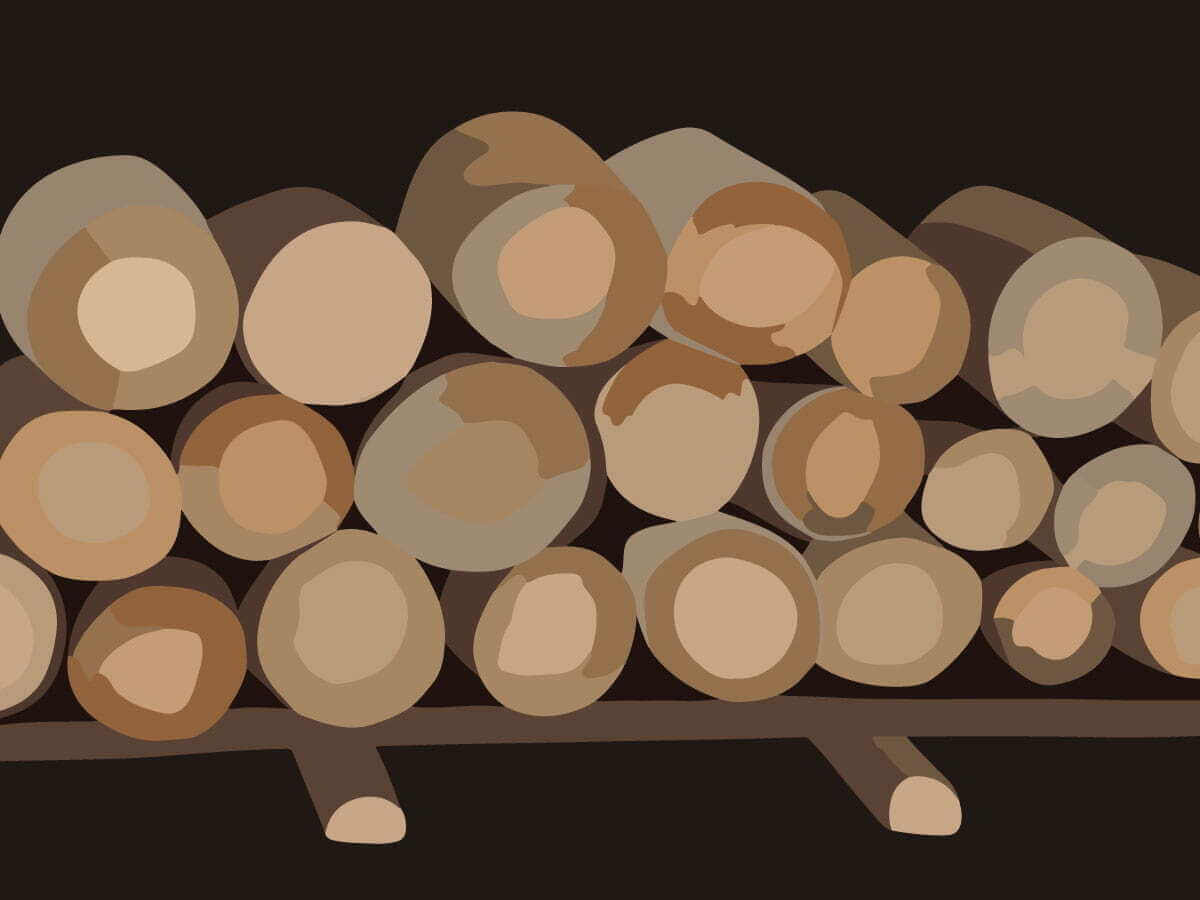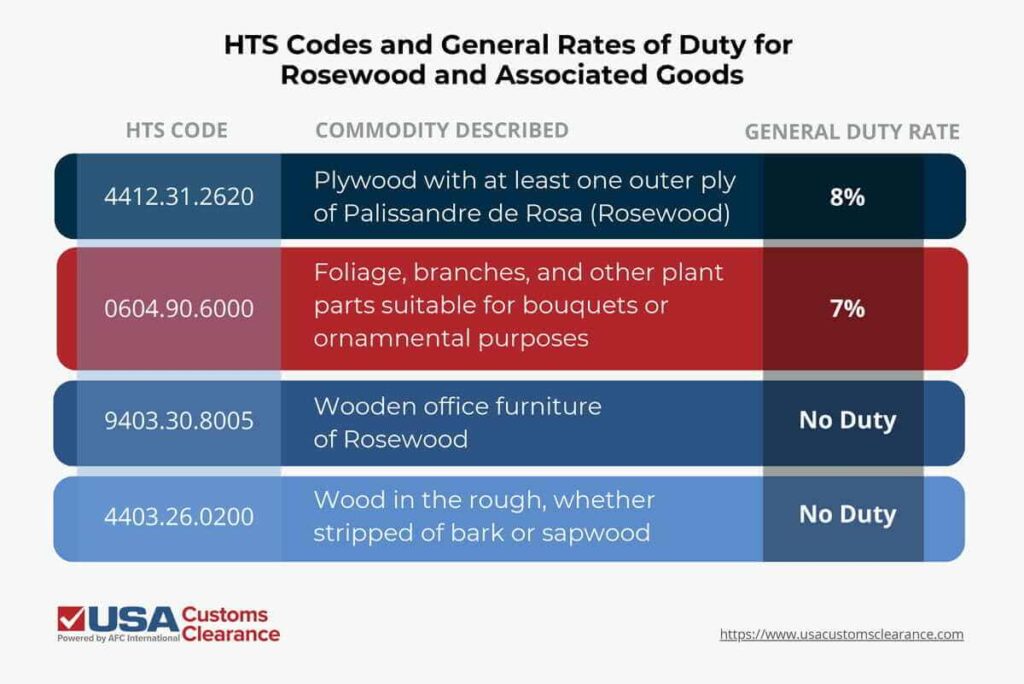
Rosewood is one of the most sought-after exotic commodities found in the world. Decorative furniture, guitars, and other items crafted from this wood command premium prices. Nevertheless, importing rosewood is a complicated task for any importer.
Key Takeaways:
If you are interested in importing such a delicate product as rosewood into the United States, we have licensed customs brokers ready to assist you.
Traditionally, rosewood has been a high-demand commodity around the world – specifically in Asia. Furniture makers prize this deep-brown wood for its aesthetics and durability, while luthiers have long profited from the deep tones it imparts to electric basses and guitars.
No matter how it’s used, rosewood lumber can be sourced from a number of different trees, and products made of rosewood often carry distinct HTS codes. This makes it one of the more difficult commodities to classify.
In order to provide some clarification, I’ve included the HTS codes of some popular forms of rosewood in the table below, along with their general rates of duty.

Classifying rosewood is further complicated by two main factors: the endangered status of the wood and exporters attempting to pass off lower-quality woods as the real thing. To address this issue, let’s start by clarifying what woods are classified under this name.
Related: Importing Wood to USA
True rosewood comes from trees in the Dalbergia genus. Many species exist in this genus, including:
Keep in mind that not all members of the Dalbergia genus are rosewood. However, ALL true rosewood comes from this genus. This is important to remember because other woods often get labeled as ‘Bolivian rosewood’ or something similar, when they’re not members of Dalbergia.
Some exporters use this confusing tactic to artificially meet the high demand for rosewood, a demand which is a direct result of overharvesting. These actions along with climate change have led to Dalbergia’s classification as an endangered species in order to prevent the plant’s extinction.

Yes, genuine rosewood is either threatened or on the brink of extinction globally. For those who wish to import this popular material into the United States, this leads to two main questions:
We can begin answering these questions by looking at the national and international organizations that play a part in protecting threatened and endangered life.
Due to its endangered status, rosewood trees are a globally protected species, with both international and state protection. You’ll need to be familiar with three protection agencies in particular when importing this material into the U.S.:
Let’s take a look at how each of these groups plays a part in regulating rosewood imports to the United States.
Related: Importing Teak Wood into the US
CITES stands for The Convention on International Trade in Endangered Species of wild fauna and flora. It is an international agreement between governments to protect plants and animals whose ongoing survival is threatened. The convention’s goal is to ensure that the trade of plants and animals does not threaten their survival.
While CITES is primarily concerned with the survival of endangered species, they don’t always outright suggest banning the import/export of these species, or at least not as a first resort.
CITES organizes endangered species into three appendices. Each appendix is outlined as follows:
Except for Dalbergia Nigra, which is found in the first appendix, all members of the genus Dalbergia are classified under appendix II.
This means that for countries that participate in CITES (including the U.S.), it is illegal to trade in Dalbergia Nigra. Specimens of this plant and lumber may be imported and exported for the purposes of scientific research, but not for trade or commercial purposes and only with permits.
The rules governing species under appendix II aren’t quite as strict. Rather than an outright trade ban, rosewoods under the second appendix can be imported and exported in limited amounts. Species covered under appendix II include Guibourtia tessmannii, also known as bubinga.
Certain finished products, such as guitars, can be made from these rosewoods and legally exported to the U.S. However, raw lumber and logs are still prohibited.
Each participating country has a government agency responsible for CITES compliance. You should visit the service’s website to learn more about their permit system. In the United States, that agency is APHIS.
Related: Importing Bamboo Products Into US
The Animal and Plant Health Inspection Service (APHIS) is part of the U.S. Department of Agriculture (USDA). They’re charged with protecting ecosystems in the USA from biological threats.
The service APHIS has three goals that pertain to rosewood:
APHIS has statutory authority for the protection of rosewood under the following federal statutes:
APHIS requires a permit for all imports of rosewood plants and products. However, even with the permit, it’s important to remember that these goods cannot be used for commercial purposes. You’ll also need to fill out form PPQ 621 to move an endangered species within U.S. borders.
A Plant & Plant Product Declaration is also required before your shipment can be processed at a U.S. port. This form is accessible electronically through the Automatic Broker Interface (ABI). You can also submit a paper form to show Customs and Border Protection (CBP).
Related: Importing Plywood to the USA
Despite protective laws and regulations in many countries, rosewood is the most trafficked timber species on earth. Much of this is due to China’s demand for the wood, which they call hongmu, in the construction of furniture.
For instance, in Africa, Senegalese loggers will cut down the rosewood trees, split them into logs, and bring them to staging areas known as depots across the Gambian border. The logs are then exported, often using deliberately incorrect HTS codes to get through customs in other countries.
For importers in the U.S., it’s important to know these practices exist, and to avoid trying to circumvent import regulations by using dishonest business practices.
If you own rosewood classified under CITES appendix I in the United States and decide to sell it, you certainly can. However, you won’t be able to export it or import more rosewood for commercial purposes. Flora under this classification can only be imported or exported for purposes such as scientific research.
To successfully import rosewood from appendix II into the U.S., you will need an export certificate from the country of origin’s CITES management authority. After you have an export certificate, have your import cleared by U.S. Customs following the various guidelines set by APHIS.
You can check the species database here for information on the specific genus of rosewood you are attempting to import.

Worried about strict regulations from APHIS and CBP?
Our 45 Minute Licensed Expert Consulting Will Personally Guide You.
Business dealings with rosewood products are not illegal; you can own, trade, or sell rosewood as long as supporting documentation is available.
However, it is illegal to import rosewood listed under CITES appendix I, such as Brazilian rosewood. This isn’t just limited to logs and lumber, either. It is also illegal to import items made of Dalbergia nigra, such as furniture and stringed instruments.
As noted earlier, in order to import rosewood listed under appendix II, you will need to consult with the country of origin’s CITES representative agency to obtain an export permit.
Understanding the regulations we’ve gone over in this article is foundational to importing rosewood. While the overall process will differ somewhat depending on your supplier, the following general steps will serve you well.
Careful preparation and understanding of CITES, APHIS, and CBP regulations can be a struggle. Enlisting assistance from a licensed customs broker is especially helpful when dealing with an endangered item protected by international law.
Related: The Complete Guide to Importing Wood Furniture to the U.S.
Due to the endangered nature of rosewood, hundreds of measures are in place globally to help ensure the survival of the species while sustaining trade. To avoid fines, delays, and other punitive actions from CBP, it’s best to work with a customs broker to import this tightly-restricted commodity.
The licensed brokers at USA Customs Clearance have helped thousands of importers like you during the complicated process of clearing U.S. customs. Whether you’re attempting to import rosewood lumber or goods made of this popular material, we can ensure your shipment includes all the required paperwork and is categorized correctly according to the HTS.
Additionally, our suite of services for importers includes:
Wood you like to learn more? If so, get in touch with us at (855) 912-0406 or submit a contact form online today!
 Copy URL to Clipboard
Copy URL to Clipboard
Hi,should I like to hand carry a personal guitar
Made if Brazilian Rosewood body.Pre convention( 1951.individual maker) name and year written in label.inside the soundhole as proof.No certificate from any other manufacturer.Do I need an import certificate from Singapore to accompany this guitar.So that I can also bring it out of America again?
Hello, is there anyway I can get back the fine from USA custom for rosewood importation from Africa? Not sure if there is any default from the third party!!!
I am Stephan Deen, 74 years old, now retired and living in Arkansas, USA. I previously lived and worked in Indonesia 1982 until late 2021. I own a rosewood 19th century Dutch colonial bed that I bought from a small, road-side antique/junk furniture shop in Jakarta, Indonesia in 1988 or 1989. It has been in storage in a friend's house in Jakarta since I returned to live in the USA in 2002. It is the only piece of antique rosewood furniture that I own in storage in Indonesia. I would like to import the bed with several other pieces of 19th centurty teak wood furniture that are in storage with it. The bed will be for my personal use at home, not for resale.
The wood in Indonesian language is "Sono-Keling" and the Latin name is "Dalbergia Latifolia." I see that it is listed on Appendix II.
Is it realistic that I can get permission to import my antique rosewood bed into my home state of Arkansas, USA? My exporter in Jakarta, Indonesia says that I should declare it as "used household goods" which is a true statement.
Thank you.
Rosewood instruments are fine and may be imported as of 2019. Brazilian rosewood is banned. There is a disconnect between these two statements and cause for confusion. If I purchase a guitar from another country that has a Brazilian rosewood fingerboard. Is that legal for import?
I am Wilson Gafurero a Kansas city missouri resident,I deal with hardwood (rosewood) in Zambia,I would like to know how I can legally import rosewood into the USA.
we are interested to import Rosewood from Zambia please advise what documentation is required for importation into USA